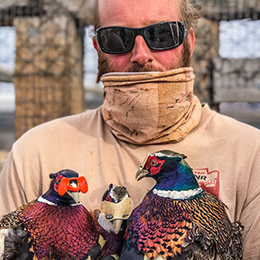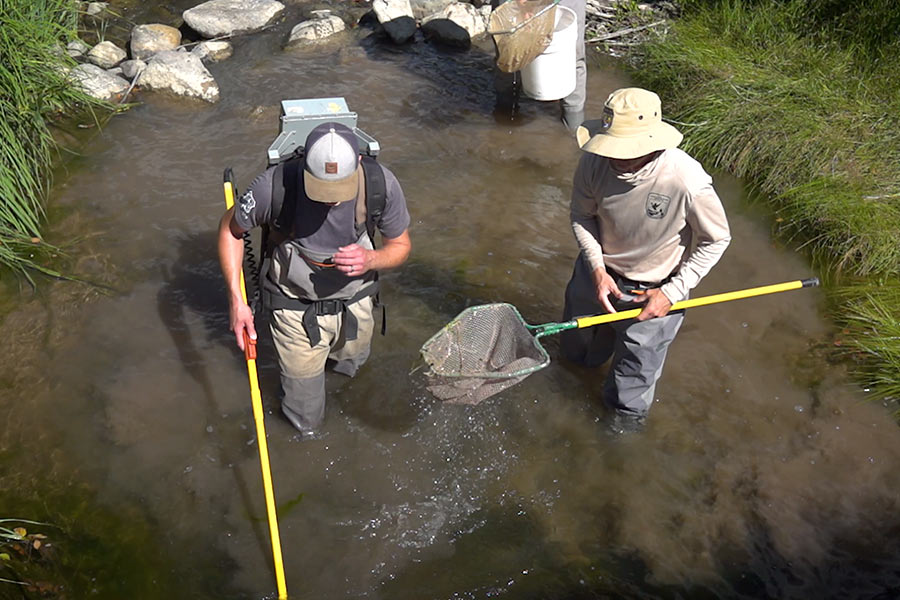Conserving wild Bonneville cutthroat trout in the midst of cattle country
A public-private partnership in southern Utah exemplifies conservation efforts that benefit both ranchers and wildlife
Adam Kavalunas
Conservation Outreach Manager, DWR Southern Region
As we passed through the gate to Johnson Mountain Ranch, the familiar rolling hills covered in scrub oak and juniper trees common in southern Utah gave the impression that our visit here wouldn't be much different than most days spent in the field. But as we would soon learn, this place is uniquely steeped in history, cooperation and giving back to the community.
And, as we soon discovered, it's home to an unexpected native fish species, as well.
Watch this video to learn more about our latest research and restoration projects at Johnson Mountain Ranch.
Shortly after arriving, we were greeted by the landowner, Jared Johnson. A quiet, unassuming man, Johnson introduced his young son Jace — dressed up in full cowboy gear — and we began talking about the working cattle ranch that has been in their family for several generations. Up until the early 1990s, both sheep and cattle were raised on the ranch, at which point the sheep were sold off, and it was converted to just a cattle ranch. In recent decades, the cattle have been used to implement a strategic habitat management plan by rotating pastures frequently, with the goal of increasing the production of forage for both livestock and wildlife.
Historically, there were no elk on Johnson Mountain Ranch, only mule deer. In the 1960s, elk were introduced into the area, and through participation in Utah's Cooperative Wildlife Management Unit program, the ranch now primarily focuses on elk hunting. One thing that makes this ranch unique is that they often invite families that are facing challenges or are less fortunate to come hunt on the property through the CWMU program.
"We try to do that every year or every other year to provide an experience that would help them," Johnson said. "It's neat to get to know the people and see the impact it has on them to enjoy what we take for granted sometimes."
Partnerships in conservation
In addition to using strict grazing practices, the ranch has worked with the U.S. Fish & Wildlife Service Partners for Fish and Wildlife Program and the Natural Resources Conservation Service to implement habitat projects to benefit all species found on the landscape. Johnson explained, "Every year we try to pick something that will improve the land, including chaining to control the pinyon and junipers, invasive weed control and fencing to protect the streams."
Over the years of multiagency partnership with the ranch, Utah Division of Wildlife Resources biologists learned there were potentially some native fish in Niotche Creek that winds its way through the property. Upon further inspection, it appeared that an unknown population of Bonneville cutthroat trout existed here. In order to confirm the suspicion, our biologists — along with other partnering scientists from the U.S. Forest Service, USFWS and NRCS — sampled the streams and submitted fish for genetic testing.
Results came back proving that a previously unknown, genetically pure strain of native Bonneville cutthroat trout resides on the property.
"This exemplifies just how important our private landowners are and what great things ranchers do for Utah's wildlife," USFWS Partners for Fish and Wildlife Utah Program Coordinator Clint Wirick said.
Habitat improvements benefit many species
Since finding this hidden population of native cutthroat, conservation partners have implemented stream, wetland, and riparian habitat restoration and enhancements in Niotche Creek. For example, restoration efforts have created more pool habitat for trout and other native fish. Pool habitat is important for summer refuge when water temperature increases. Ongoing restoration efforts also reduce erosion, increase wetted soils around the stream to grow more vegetation, and allow sediment coming down to drop out and improve downstream water quality. Additionally, some wildlife-friendly fencing was constructed to give the ranch more grazing management options.
Before vs. after comparison of Niotche Creek, which underwent habitat restoration and enhancements after the discovery of a local population of Bonneville cutthroat trout. Move the horizontal slider bar to the right to show the habitat after restoration.
Benefits from the stream work are already being noticed. "It's really satisfying to see almost instantaneous improvements after doing this work. Seeing more water on the landscape gives us hope that we can benefit all the wildlife and livestock that call this ranch home,” said Jacob Hall, a DWR/NRCS wildlife biologist."
Division aquatic biologist Mike Hadley provided some more context for our findings. "Provided the fish are disease free, this population of trout can be used for introductions in other areas as part of our conservation efforts. Other native fish species we found in the creek include mottled sculpin, mountain sucker and speckled dace," Hadley said.
Moving forward, we will be working with the USFS to continue to monitor the cutthroat trout population on adjacent public lands, along with continuing stream restoration efforts.
"It's a neat opportunity for anglers to catch Utah's state fish, a fish that's always existed here in the state," said USFS biologist Jens Swensen.
Like many ranches in Utah, Johnson Mountain Ranch is tucked away from the bustling cities, operating quietly on its own and doing what it can day by day to make the land better. What makes this place special is the willingness of the landowners to welcome in the many agencies that strive to make Utah's natural resources the best they can be. Without partnerships like this, landscape-level conservation efforts can be difficult, if not almost impossible.
We look forward to what the future brings about with this partnership, and the possibility of many more like it.

















